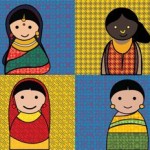India is a land of rich cultural heritage and a home to many art forms. Amongst these, various kinds of indigenous styles of paintings and folk art available here, deserve special mention. Not only are these paintings exotic, each of them has a rich historical perspective. Let’s look at a few.
1. Patachitra
‘Pata’ indicates ‘vastra’ or clothing, and ‘chitra’ means painting. This special painting on cloth is a special art form of Orissa. To make the canvas, the painters use fine gauze-like cloth, which they fortify with tamarind paste, chalk powder and gum. After drying the canvas, the patachitra painters draw the most intricate designs on it and color it with natural dyes. The patachitra paintings adorn the stories of the epic Ramayana and the Mahabharata, and those of the local deity Lord Jagannath.
Patachitra can be dated back to the 5th century BC. It is an art form developed lovingly by the locals of Raghurajpur, Puri, Sonepur, etc. The appearance of the paintings became more widespread with the construction of the great temples of Puri, Konark and Bhubaneswar. A plethora of paintings appeared in temples and maths around the 18th century, and the pattastyle of painting patachitra developed with the setting up of the Jagannath temple.
2. Bengal Pat
Like the Patachitra in Orissa, the indigenous art form that developed in Bengal came to be known as Bengal Pat. Paintings are made with dyes made from spices, earth, soot, etc. and reflect the life and times of the society and folklore. The traditional colors used in Bengal Pat are red, indigo, green, black and ochre. Bengal Pat has a very interesting angle to it. Some paintings depict spoofs on retrograde social practices, thus attempting to highlight them for change.
This art form of Bengal developed hundreds of years back when roaming minstrels used to sing about incidents of the distant past and popular lore to villagers. Some of these artists started depicting these stories on cloth scrolls for preservation and beatification.
3. Madhubani Painting
The folk painting of Bihar is known as Madhubani painting or Maithili painting, names taken from the regions of origin, namely, Madhuban and Mithila. The paintings are developed on various geometrical designs and the characters are portrayed with large soulful eyes and a colorful environment. Stories from the mythologies are depicted in these paintings and Lord Krishna is a favorite subject.
Origin and history of Madhubani or Maithili painting cannot be traced. Mithila is believed to be the kingdom of King Janak, the father of Sita. The art that prevailed at the time of Ramayana in Mithila may have developed down the ages into Maithili art. The age-old tradition of wall paintings in Bihar had a significant role to play in the development of this art form.
4. Miniature Painting
As the name suggests, miniature paintings refer to paint works that are small in size but capture great detail of subject and expression in the work. In India, miniature paintings form a broad category, including an abundance of Mughal miniature paintings that depict the court life and the contemporary personalities, events and actions of the Mughal times. The main characteristic of the miniature paintings is the intricate brushwork and the vibrant colours made from semi-precious stones, conch shells, gold and silver.
Developed during the Mughal Period (16th – 19th century), Indian miniature paintings have a touch of Persian miniature. Though miniature paintings developed in the Mughal courts, the style was adopted by the Hindus (Rajputs) and later the Sikhs. Mughal miniatures flourished under the reign of Akbar, Jahangir and Shah Jahan. There are quite a few of these paintings curated and preserved.
5. Gond Art
Gond art is a form of tribal art developed by the Gonds of central India. This art has been inspired by the hills, streams and forests in which the Gonds live. Nature and social customs are depicted by the Gond artists with a series of dots and dashes intricately arranged into forms. Gond paintings are made on walls, ceilings and floors of village houses in honour of customs and festivals. The Gonds also believe that their paintings are infused with a luck factor.The paintings are a combination of earth tones and vibrant hues, which bring the canvas to life.
The technique of Gond art can be traced back to the old art of tattooing which is common among the Gonds. The paintings began with an attempt to record folklore and tribal stories sung by wandering poets and singers. Capturing stories in art has been a common practice in India.
6. Tanjore Art
Southern Tamil Nadu is famous for its Tanjore paintings. An art form that flourished in Tanjore in the yester years, the painting style is still popular and widely learnt. The paintings are made with semi-precious stones, glass and gold. They look very beautiful and add a touch of grandeur to their surroundings. The characters of these paintings are mainly gods and goddesses with large round faces and embellished designs.
This art form flourished around 16th to 18th century in Tanjore under the Cholas and was patronized by the princes, Nayaks, Naidus and developed as a scared art. The popularity of this art coincided with a time, when magnificent temples were being built by various rulers and hence, the subject revolved around the divine.
7. Kalamkari
This style of painting has got its name from the method of craftsmanship – ‘kalam’ meaning pen and ‘kari’ meaning work. The artists use fine pens made of bamboo dipped in vegetable dyes to draw. Drawings are made up of fine lines and intricate designs. This style of painting was developed in Kalahasti near Chennai and Masulipatnam near Hyderabad. Kalahasti kalamkari developed near temples and therefore has mythological theme. Some Kalamkari paintings show touches of Persian influence in motifs and design.
Kalamkari painting flourished during the Maratha rule and developed a style called the Karuppur. It’s a worked on fabric which is enhanced with gold brocade for the royal families.
Which form of painting attracted you the most? Go ahead and buy one for your wall.
Anjali Nayyar
Latest posts by Anjali Nayyar (see all)
- 7 Places To Visit With Your Parents To Relive Your Childhood Days - January 14, 2021
- 9 Insanely Breathtaking Destinations For A Braveheart Traveller - January 7, 2021
- Ebola Can’t Lessen Our Love For Africa – 7 Safe Places To Travel To - December 29, 2020





















